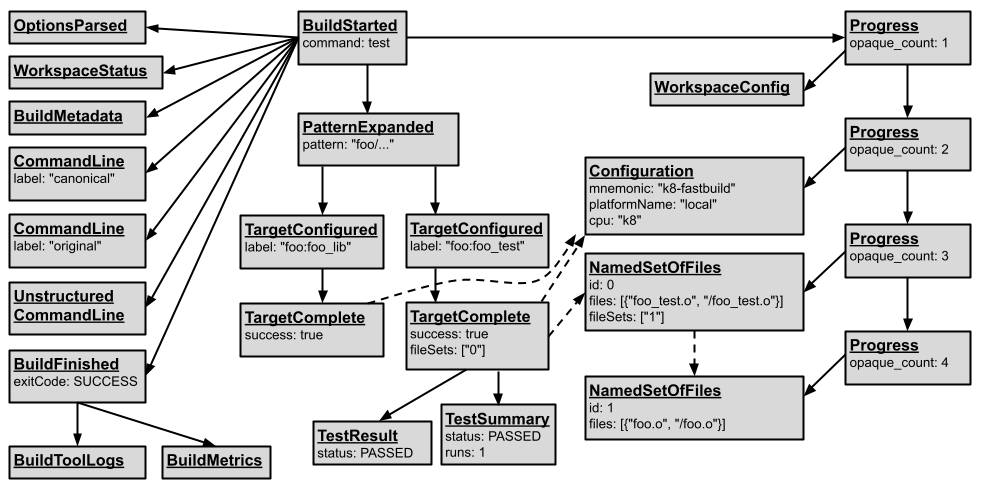The full specification of the Build Event Protocol can be found in its protocol buffer definition. However, it might be helpful to build up some intuition before looking at the specification.
Consider a simple Bazel workspace that consists of two empty shell scripts
foo.sh and foo_test.sh and the following BUILD file:
sh_library(
name = "foo_lib",
srcs = ["foo.sh"],
)
sh_test(
name = "foo_test",
srcs = ["foo_test.sh"],
deps = [":foo_lib"],
)
When running bazel test ... on this project the build graph of the generated
build events will resemble the graph below. The arrows indicate the
aforementioned parent and child relationship. Note that some build events and
most fields have been omitted for brevity.

Figure 1. BEP graph.
Initially, a BuildStarted event is published. The event informs us that the
build was invoked through the bazel test command and announces child events:
OptionsParsedWorkspaceStatusCommandLineUnstructuredCommandLineBuildMetadataBuildFinishedPatternExpandedProgress
The first three events provide information about how Bazel was invoked.
The PatternExpanded build event provides insight
into which specific targets the ... pattern expanded to:
//foo:foo_lib and //foo:foo_test. It does so by declaring two
TargetConfigured events as children. Note that the TargetConfigured event
declares the Configuration event as a child event, even though Configuration
has been posted before the TargetConfigured event.
Besides the parent and child relationship, events may also refer to each other
using their build event identifiers. For example, in the above graph the
TargetComplete event refers to the NamedSetOfFiles event in its fileSets
field.
Build events that refer to files don’t usually embed the file
names and paths in the event. Instead, they contain the build event identifier
of a NamedSetOfFiles event, which will then contain the actual file names and
paths. The NamedSetOfFiles event allows a set of files to be reported once and
referred to by many targets. This structure is necessary because otherwise in
some cases the Build Event Protocol output size would grow quadratically with
the number of files. A NamedSetOfFiles event may also not have all its files
embedded, but instead refer to other NamedSetOfFiles events through their
build event identifiers.
Below is an instance of the TargetComplete event for the //foo:foo_lib
target from the above graph, printed in protocol buffer’s JSON representation.
The build event identifier contains the target as an opaque string and refers to
the Configuration event using its build event identifier. The event does not
announce any child events. The payload contains information about whether the
target was built successfully, the set of output files, and the kind of target
built.
{
"id": {
"targetCompleted": {
"label": "//foo:foo_lib",
"configuration": {
"id": "544e39a7f0abdb3efdd29d675a48bc6a"
}
}
},
"completed": {
"success": true,
"outputGroup": [{
"name": "default",
"fileSets": [{
"id": "0"
}]
}],
"targetKind": "sh_library rule"
}
}
Aspect Results in BEP
Ordinary builds evaluate actions associated with (target, configuration)
pairs. When building with aspects enabled, Bazel
additionally evaluates targets associated with (target, configuration,
aspect) triples, for each target affected by a given enabled aspect.
Evaluation results for aspects are available in BEP despite the absence of
aspect-specific event types. For each (target, configuration) pair with an
applicable aspect, Bazel publishes an additional TargetConfigured and
TargetComplete event bearing the result from applying the aspect to the
target. For example, if //:foo_lib is built with
--aspects=aspects/myaspect.bzl%custom_aspect, this event would also appear in
the BEP:
{
"id": {
"targetCompleted": {
"label": "//foo:foo_lib",
"configuration": {
"id": "544e39a7f0abdb3efdd29d675a48bc6a"
},
"aspect": "aspects/myaspect.bzl%custom_aspect"
}
},
"completed": {
"success": true,
"outputGroup": [{
"name": "default",
"fileSets": [{
"id": "1"
}]
}]
}
}
Consuming NamedSetOfFiles
Determining the artifacts produced by a given target (or aspect) is a common
BEP use-case that can be done efficiently with some preparation. This section
discusses the recursive, shared structure offered by the NamedSetOfFiles
event, which matches the structure of a Starlark Depset.
Consumers must take care to avoid quadratic algorithms when processing
NamedSetOfFiles events because large builds can contain tens of thousands of
such events, requiring hundreds of millions operations in a traversal with
quadratic complexity.

Figure 2. NamedSetOfFiles BEP graph.
A NamedSetOfFiles event always appears in the BEP stream before a
TargetComplete or NamedSetOfFiles event that references it. This is the
inverse of the "parent-child" event relationship, where all but the first event
appears after at least one event announcing it. A NamedSetOfFiles event is
announced by a Progress event with no semantics.
Given these ordering and sharing constraints, a typical consumer must buffer all
NamedSetOfFiles events until the BEP stream is exhausted. The following JSON
event stream and Python code demonstrate how to populate a map from
target/aspect to built artifacts in the "default" output group, and how to
process the outputs for a subset of built targets/aspects:
named_sets = {} # type: dict[str, NamedSetOfFiles]
outputs = {} # type: dict[str, dict[str, set[str]]]
for event in stream:
kind = event.id.WhichOneof("id")
if kind == "named_set":
named_sets[event.id.named_set.id] = event.named_set_of_files
elif kind == "target_completed":
tc = event.id.target_completed
target_id = (tc.label, tc.configuration.id, tc.aspect)
outputs[target_id] = {}
for group in event.completed.output_group:
outputs[target_id][group.name] = {fs.id for fs in group.file_sets}
for result_id in relevant_subset(outputs.keys()):
visit = outputs[result_id].get("default", [])
seen_sets = set(visit)
while visit:
set_name = visit.pop()
s = named_sets[set_name]
for f in s.files:
process_file(result_id, f)
for fs in s.file_sets:
if fs.id not in seen_sets:
visit.add(fs.id)
seen_sets.add(fs.id)
